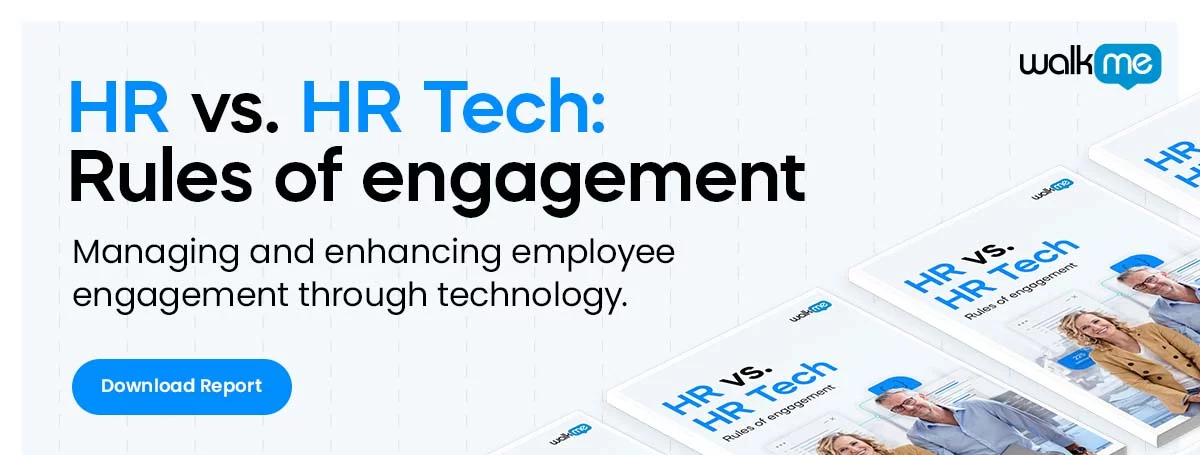
Did you know employee onboarding is essential to creating a productive and successful work environment?
Gartner has identified the following initiatives that HR leaders should follow to connect new hires to the company culture through onboarding:
- Revamp the onboarding process to focus not only on productivity but also on building connections.
- Link organizational values to on-the-job decisions
- Support the development of cross-functional networks
According to research by Brandon Hall Group, companies with a robust onboarding process can enhance employee retention by 82 percent and boost productivity by more than 70 percent.

And according to a recent Gallup poll, disengaged employees have caused the world economies to lose $7.8 trillion in productivity. In the United States alone, the cost of disengaged employees ranges from $450 to $500 billion every year, which means that for every $10,000 salary, the cost is $3,400.
To ensure new employees receive adequate training and support, it is important to evaluate their onboarding experience. And conducting a post-onboarding training survey can highlight areas in need of improvement and identify new training needs for team members.
Michelle Smith, Vice President of Marketing for O.C. Tanner, a consulting company for employee recognition and incentives, says, “Up to 20 percent of employee turnover happens within the first 45 days. This percentage is even greater with “emerging adults” who have a different definition of success compared to other generations.”

This article will discuss the use of post-onboarding surveys to gather feedback from new employees. It includes 30 sample survey questions, explains the advantages of using these surveys, and lists the top four survey tools for collecting post-onboarding feedback.
What Is an employee post-onboarding survey questions?

An employee post-onboarding survey is a questionnaire designed to evaluate how well an organization has prepared and supported its new hires. Post-onboarding surveys are conducted after the onboarding process is complete and can be used to identify areas of improvement, measure team performance, and discover new training needs.
Example of post-onboarding survey
Organizations can gather employee feedback after onboarding to identify areas of success and areas that need improvement. Getting this feedback is crucial to ensure every employee’s onboarding process is interesting and efficient, regardless of their type.
L&D teams should consider using certain types of questions, such as:
- Open-ended survey questions
- 1-10 scale survey questions
- Likert scale survey questions
Example of a Likert scale onboarding survey question:
By conducting these surveys, you can assess how effectively your employees have adapted to their new responsibilities. Evaluating your employees’ satisfaction with the onboarding process can help you determine if they have the necessary tools to perform their new job effectively.
Introducing and integrating new employees requires a significant amount of time and effort. Onboarding surveys can provide valuable insight into how successful the process was for your team. It is also an effective way to ensure the organization offers employees a productive and successful work environment.
A positive onboarding experience is crucial to developing a healthy workplace culture. Surveys allow the organization to evaluate and improve its onboarding process while allowing new employees to provide feedback on their experiences.
30 Examples of Employee Onboarding Survey Questions to Ask New Hires
- Which part of the onboarding process did you like the most?
- Were there any parts that were confusing or unclear?
- Was anything missing from the process?
- On a scale of 1 to 10, how satisfied are you with working for our organization?
- Do you have any suggestions for improving the onboarding process?
- Do you comprehend how your position supports the overall objective of the business?
- How do you feel about your orientation materials (e.g., handbook, policies)?
- Do you have any questions about the company policies?
- Do you have any queries about your tasks or responsibilities at work?
- Was the pace of the onboarding process comfortable for you?
- On a scale of 1 to 10, how welcome do you feel here?
- Do you feel proficient with the tools required for your role?
- What else do you need to learn to perform your job effectively?
- How do you feel about our organizational values?
- Do your values align with the values of our organization?
- How well does your role match the job description?
- Were your expectations met during the onboarding process?
- Did you encounter any specific issues during the onboarding process that you disliked?
- Was the orientation process sufficient in preparing you for your job?
- Did you receive satisfactory answers to all your questions during the onboarding process?
- Did you find the orientation program to be informative and interesting?
- Since you joined the organization, what kind of support have you received?
- Are you satisfied with how valued you are as a team member?
- Did you experience any challenges in obtaining the required resources?
- Is your supervisor available to answer questions?
- Do you feel comfortable asking questions to your supervisor or other colleagues?
- On a scale of 1 to 10, how confident are you in performing your role?
- What training could be provided to help you in fulfilling your role better?
- How can the organization support you in reaching your goals in the role?
- Do you have any suggestions to improve the onboarding process for future employees?
5 Benefits of Post-Onboarding Employee Surveys

Onboarding program evaluations through surveys help HR teams assess their quality and effectiveness. They provide a comprehensive understanding of the benefits employees receive from a well-planned onboarding process. The survey responses can be feedback or ideas to improve the onboarding experience.
Below are five advantages of conducting employee surveys after the onboarding process:
- Identifying Trends: Post-onboarding surveys help employers identify trends in employee onboarding experiences. By analyzing the responses, employers can identify areas for improvement and address any common issues or concerns consistently reported by new hires. This can lead to a more effective onboarding process and improved employee experience.
- Measuring Success: Post-onboarding surveys allow employers to measure the success of their onboarding program. By collecting data on various aspects of the onboarding process, such as training effectiveness and communication clarity, employers can determine if any changes need to be made to ensure a more successful experience for new hires going forward.
Effective onboarding is crucial for any organization, but how do you know if your efforts are truly hitting the mark? One way to assess the effectiveness of your onboarding process is by gauging employee sentiment towards different aspects of it. For example, if an employee on the workforce management team has received training on using a work schedule maker, their feedback on the quality and relevance of the training can help you determine whether your approach to tools training is effective.
But how do you gather this feedback in a timely and actionable way? That’s where a digital adoption platform like WalkMe comes in. By soliciting feedback from new hires as they complete each training program, you can capture their thoughts and impressions while the information is still fresh in their minds. With this valuable insight, you can continuously refine and improve your onboarding process to ensure that new hires are set up for success from day one.
- Increasing Retention Rates: Surveys provide valuable insight into how new employees feel about their roles. Employers can use this feedback to identify any issues or concerns that could potentially lead to early turnover and take steps to address them. Employers can increase retention rates and reduce turnover by improving the onboarding experience and addressing employee concerns.
- Understanding Employee Needs: Post-onboarding surveys provide employers with valuable feedback on the tools and resources needed to help employees succeed. By understanding the needs of new hires, employers can provide the necessary support and resources to help employees perform their jobs effectively and achieve their goals.
- Showing Appreciation: By conducting post-onboarding surveys, employers demonstrate to new hires that their opinions and feedback are valued. This can help create a more positive work environment and foster trust in the workplace. Employees who feel appreciated and heard are likelier to be engaged, productive, and loyal to the company.
The benefits above reflect why it is important for employers to incorporate post-onboarding surveys into their onboarding process. Doing so can help ensure new hires have a positive and successful experience as they transition into the organization.
4 Best Survey Tools for Employee Onboarding Feedback in 2023
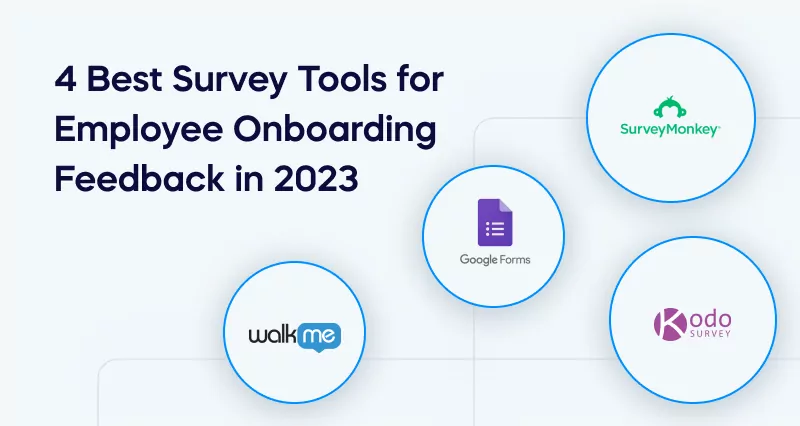
Collecting feedback from employees is crucial for any organization.
Over 400 survey software tools are on the market, but some offer more than just basic surveys. Comprehensive learning and development tools incorporate feedback surveys into the onboarding experience, allowing businesses to tailor their process to better meet the needs of new hires.
These tools also help track progress and identify new employees’ challenges, providing necessary support. Investing in these tools leads to a more engaged workforce, attracting and retaining top talent, boosting productivity, and driving business success.
In 2023, HR teams should consider exploring four highly recommended software tools for administering post-onboarding feedback surveys:
WalkMe
WalkMe’s Digital Adoption Platform (DAP) empowers businesses to streamline their processes and workflows by utilizing data from their business applications. Its user-friendly interface simplifies the user experience, making it easy for your employees to take action and become more efficient in their roles.
By gaining visibility into application usage and user journeys, you’ll have access to valuable data-driven insights that allow you to identify areas for improvement and optimize digital adoption across your organization.
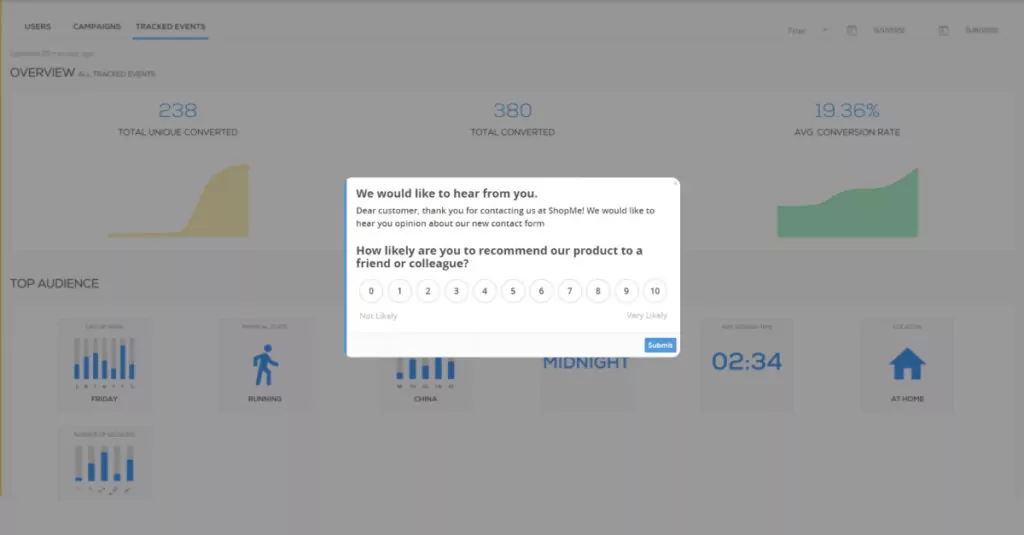
With the WalkMe DAP, you can improve employee productivity, reduce training costs, and accelerate your return on investment, all while increasing user satisfaction.
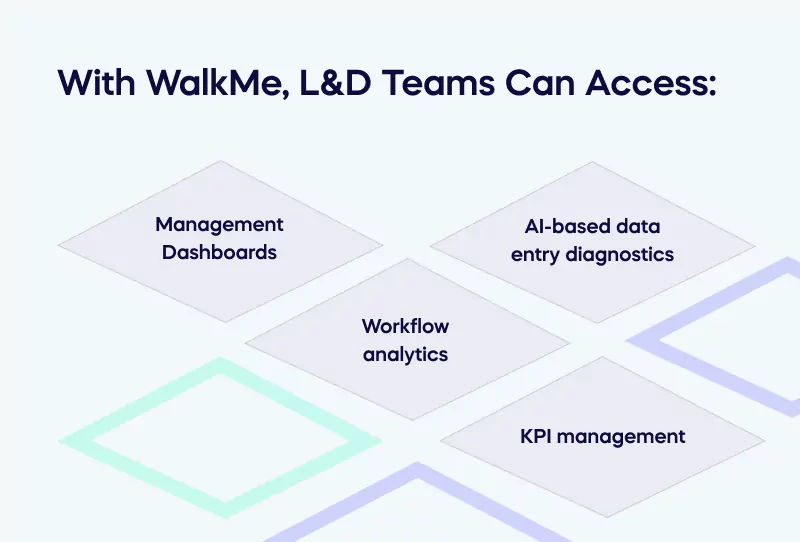
With WalkMe, L&D Teams Can Access:
- Management Dashboards – Through AI, WalkMe instantly provides organizations with unified observability and visibility on top of their current mesh of systems and workflows.
- Workflow analytics – Gain visibility into user experiences across applications, pinpoint where users struggle, and continuously optimize experiences to keep up with change.
- AI-based data entry diagnostics – WalkMe’s UI Intelligence surfaces AI-based insights to help improve data integrity and efficient process completion.
- KPI management – Prove adoption and digital transformation success by tracking and automatically reporting on KPIs defined by project leaders.
WalkMe’s DAP lets you leverage data to design and deploy user experiences that increase adoption and engagement across workflows and applications.
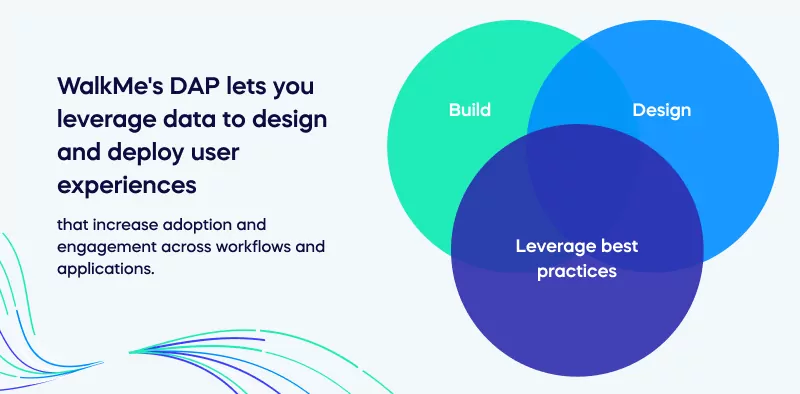
- Build – WalkMe’s no-code editor allows organizations to take immediate action to fix what is broken across workflows and applications without relying on developers or release cycles.
- Design – Design data-driven experiences in the form of automation, a conversational interface, tooltips, on-screen guidance, or other changes to the UI using our digital adoption platform.
- Leverage best practices – Leverage best-practice templates and pre-built solutions for quicker time-to-value.
WalkMe provides customized training during the course of work to make employee onboarding more efficient. It facilitates onboarding workers to software applications across all technologies, whether novice employees or adapting to new software.
WalkMe’s digital adoption platform offers a comprehensive solution to help businesses gain visibility into employee experiences and increase user productivity. With WalkMe’s analytics capabilities, companies can gain insights into how employees interact with their digital systems and identify areas for improvement. This provides a solid foundation for any digital transformation initiative, ensuring the technology stack is used effectively and efficiently.
WalkMe’s training and support offerings can assist in increasing user productivity. By leveraging WalkMe’s guided workflows, businesses can train new users quickly and efficiently, reducing the time to productivity and improving user proficiency. This allows users to become more productive and successful in their roles, ultimately driving success and growth for the organization.
Overall, WalkMe’s digital adoption platform is ideal for businesses looking to optimize their technology use, improve employee experiences, and achieve success in digital transformation. With its advanced analytics and training capabilities, WalkMe empowers businesses to realize the full potential of their technology investments and drive long-term growth.
Google Forms

Google Forms is a platform that makes survey data more user-friendly and easier to access. It’s smart design and interactive interface enable effortless survey creation for HR managers. Participants can also easily answer surveys without any issues. Google Forms is one of the best survey platforms available for large-scale surveys due to its lack of a learning curve and seamless integration with Google Sheets.
Google Forms can create feedback surveys and polls, quickly capture employee data, or gather customer insights. HR managers can also create surveys to gather insights into employee engagement, performance reviews, and more.
Kodo Survey
Kodo Survey is a platform designed to simplify survey creation and distribution. Its intuitive user interface lets users quickly create surveys and share them with their teams. Kodo Survey also has powerful analytics capabilities that enable users to gain insights into survey data for better decision-making.
The comprehensive reports provide information on every new hire’s opinion about the onboarding process, which helps the HR team optimize the onboarding experience more effectively. Kodo Survey allows HR managers to make strategic decisions based on accurate information instead of relying solely on their initial impressions as they did in the past.
SurveyMonkey
SurveyMonkey is a user-friendly survey tool that is highly effective, particularly for onboarding, when gathering employee feedback. HR teams can enhance the efficiency of their employee surveys by taking advantage of SurveyMonkey’s simple templates and custom questionnaires for collecting data.
SurveyMonkey also offers features such as automated reminders, which can be used to follow up with participants who have not completed their surveys. It also provides detailed insights into survey responses, which can help HR teams understand the issues that employees are facing and devise appropriate solutions to address them.
Improve your onboarding effectiveness and experience with post-onboarding feedback surveys
As a business owner or manager, you know that employee feedback is crucial to the success of your organization. However, creating surveys can be time-consuming, and getting employees to engage with them can be challenging. That’s where WalkMe comes in.
WalkMe is a powerful digital adoption platform that allows organizations to easily create engaging and interactive employee surveys. With WalkMe, you can create onboarding programs that provide contextual self-help to your new hires, which helps drive the adoption of your digital applications and processes. This reduces training time and content creation costs and helps new employees retain critical knowledge.
What differentiates WalkMe from other survey tools is its ability to create customized surveys tailored to your organization’s unique needs. Whether you need to collect feedback on a specific process, gauge employee satisfaction, or measure engagement, WalkMe makes creating surveys that get results easy. Plus, with its intuitive and user-friendly interface, you can have your surveys up and running quickly.

By using WalkMe, you’ll be able to gather valuable insights into your organization and make informed decisions that help drive growth and success. So why wait? Sign up for WalkMe today and start creating engaging surveys that deliver real results for your business.
WalkMe Team
WalkMe spearheaded the Digital Adoption Platform (DAP) for associations to use the maximum capacity of their advanced resources. Utilizing man-made consciousness, AI, and context-oriented direction, WalkMe adds a powerful UI layer to raise the computerized proficiency, everything being equal.
